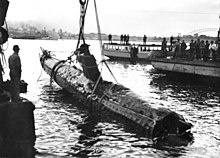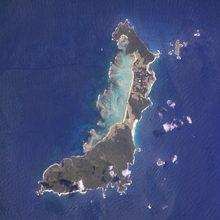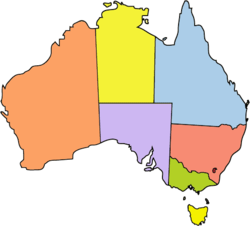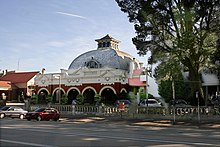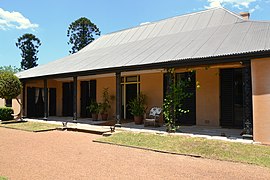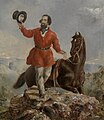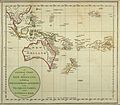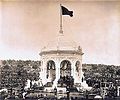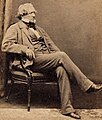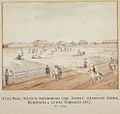Portal maintenance status: (June 2018)
|
The New South Wales Portal


New South Wales (commonly abbreviated as NSW) is a state on the east coast of Australia. It borders Queensland to the north, Victoria to the south, and South Australia to the west. Its coast borders the Coral and Tasman Seas to the east. The Australian Capital Territory and Jervis Bay Territory are enclaves within the state. New South Wales' state capital is Sydney, which is also Australia's most populous city. In December 2023[update], the population of New South Wales was over 8.3 million, making it Australia's most populous state. Almost two-thirds of the state's population, 5.3 million, live in the Greater Sydney area.
The Colony of New South Wales was founded as a British penal colony in 1788. It originally comprised more than half of the Australian mainland with its western boundary set at 129th meridian east in 1825. The colony then also included the island territories of Van Diemen's Land, Lord Howe Island, and Norfolk Island. During the 19th century, most of the colony's area was detached to form separate British colonies that eventually became the various states and territories of Australia. The Swan River Colony (later called the Colony of Western Australia) was never administered as part of New South Wales. (Full article...)
 Recognized content - load new batch
Recognized content - load new batch 
-
Image 1A Japanese Ko-hyoteki class midget submarine, believed to be midget No. 14, is raised from Sydney Harbour the day after the attack.
From 31 May to 8 June 1942, during World War II, Imperial Japanese Navy submarines made a series of attacks on the Australian cities of Sydney and Newcastle. On the night of 31 May – 1 June, three Ko-hyoteki-class midget submarines (M-14, M-21 and M-24), each with a two-member crew, entered Sydney Harbour, avoided the partially constructed Sydney Harbour anti-submarine boom net, and attempted to sink Allied warships. Two of the midget submarines were detected and attacked before they could engage any Allied vessels. The crew of M-14 scuttled their submarine, whilst M-21 was successfully attacked and sunk. The crew of M-21 killed themselves. These submarines were later recovered by the Allies. The third submarine attempted to torpedo the heavy cruiser USS Chicago, but instead sank the converted ferry HMAS Kuttabul, killing 21 sailors. This midget submarine's fate was unknown until 2006, when amateur scuba divers discovered the wreck off Sydney's northern beaches.
Immediately following the raid, the five Japanese fleet submarines that carried the midget submarines to Australia embarked on a campaign to disrupt merchant shipping in eastern Australian waters. Over the next month, the submarines attacked at least seven merchant vessels, sinking three ships and killing 50 sailors. During this period, between midnight and 02:30 on 8 June, two of the submarines bombarded the ports of Sydney and Newcastle. (Full article...) -
Image 2
Steven Peter Devereux Smith (born 2 June 1989) is an Australian international cricketer, former captain of the Australian national team in all three formats of the game and the current vice-captain of the Australia Test team. He is regarded by many as the best Test batsmen of his generation and one of the greatest Test batsmen of all time, having scored over 10,000 Test runs.
Smith was a member of the Australian teams that won the 2015 and 2023 Cricket World Cup, the 2021 ICC T20 World Cup, and the 2023 ICC World Test Championship.
Although he was initially selected for Australia as a leg-spinning all-rounder in 2010, Smith was always earmarked as a batting prospect following successful batting campaigns in domestic cricket early in his career. Smith now plays primarily as a batsman who bowls occasionally. After playing five Test matches from 2010 to 2011 as a bowling all-rounder, he was recalled to the Australian Test team in 2013 as a batsman and took over the captaincy from Michael Clarke in late 2015, after which he predominantly batted at number 3 or 4 across all formats. (Full article...) -
Image 3The 1994 FIFA World Cup CONCACAF–OFC qualification play-off was an association football match played over two legs between Australia and Canada. The first leg was played at Commonwealth Stadium in Edmonton, Canada, on 31 July 1993; the second leg was played on 15 August 1993 at Sydney Football Stadium in Sydney, Australia.
Both teams had played in their regional qualifiers to qualify for the play-off. The Canadians played in twelve matches in North American qualifying across two rounds. After finishing second in their second-round group to El Salvador, they qualified to the final round where they finished second by three points to Mexico. Australia played in six matches across two rounds in Oceania qualifying. After winning their group, they defeated New Zealand across two legs to make it to the play-off. (Full article...) -
Image 4
Maddison Gae Elliott, OAM (born 3 November 1998) is an Australian swimmer. At the 2012 Summer Paralympics in London, she became the youngest Australian Paralympic medallist by winning bronze medals in the women's 400 m and 100 m freestyle S8 events. She then became the youngest Australian gold medallist when she was a member of the women's 4 × 100 m freestyle relay 34 points team. At the 2016 Rio Paralympics, she won three gold and two silver medals. (Full article...) -
Image 5
Monaro Highway is a 285-kilometre-long (177 mi) highway in Victoria, New South Wales, and the Australian Capital Territory, in Australia, linking Cann River in Victoria to Canberra in the Australian Capital Territory (ACT) via the Monaro region. From its southern terminus, it follows the nearby Cann River upstream towards the New South Wales border through heavily forested terrain. Within New South Wales (NSW), it makes its way through further forest before reaching the pastures typical of the Monaro. There are multiple towns and villages along the highway, including Bombala, Nimmitabel and Cooma. The terrain within the Monaro is largely hilly, and there are numerous crossings. The road also parallels the former Bombala railway line in several locations. Within the ACT, the road becomes a high volume roadway and serves the southern suburbs of Canberra. The highway has more recently had a grade-separated dual carriageway extension constructed within Canberra, as part of the Eastern Parkway construction project. It is designated part of route M23, and route A23 within Canberra, and route B23 within Victoria and New South Wales, with a concurrency where it also carries route B72 between the two sections of Snowy Mountains Highway. (Full article...) -
Image 6Hailstones dropped during the storm, compared to a cricket ball (7 cm or 2.8 in diameter)
The 1999 Sydney hailstorm was the costliest natural disaster in Australian insurance history, causing extensive damage along the east coast of New South Wales. The storm developed south of Sydney on the afternoon of Wednesday, 14 April 1999, and struck the city's eastern suburbs, including the central business district, later that evening.
The storm dropped an estimated 500,000 tonnes of hailstones in its path. The insured damage bill caused by the storm was over A$1.7 billion (equivalent to $3.8 billion in 2022), with the total bill (including uninsured damage) estimated to be around $2.3 billion. It was the costliest single natural disaster in Australian history in insured damage, surpassing the $1.1 billion in insured damage caused by the 1989 Newcastle earthquake. Lightning also claimed one life during the storm, and the event caused approximately 50 injuries. (Full article...) -
Image 7
Summer Hill is a suburb of Sydney, in the state of New South Wales, Australia. Summer Hill is located 7 kilometres west of the Sydney central business district, in the local government area of the Inner West Council.
Summer Hill is a primarily residential suburb of Sydney's Inner West, adjoining two of Sydney's major arterial roads, Parramatta Road and Liverpool Road. The first land grant was made in 1794 to former convict and jailor Henry Kable, and the suburb began growing following the opening of the railway station on the Main Suburban railway line, in 1879. (Full article...) -
Image 8

Persoonia linearis, commonly known as the narrow-leaved geebung, is a shrub native to New South Wales and Victoria in eastern Australia. It reaches 3 m (9.8 ft), or occasionally 5 m (16 ft), in height and has thick, dark grey papery bark. The leaves are, as the species name suggests, more or less linear in shape, and are up to 9 cm (3.5 in) long, and 0.1 to 0.7 cm (0.039 to 0.276 in) wide. The small yellow flowers appear in summer, autumn and early winter (December to July), followed by small green fleshy fruit known as drupes. Within the genus Persoonia, it is a member of the Lanceolata group of 58 closely related species. P. linearis interbreeds with several other species where they grow together.
Found in dry sclerophyll forest on sandstone-based nutrient-deficient soils, P. linearis is adapted to a fire-prone environment; the plants resprout epicormic buds from beneath their thick bark after bushfires. The fruit are consumed by vertebrates such as kangaroo, possums and currawongs. As with other members of the genus, P. linearis is rare in cultivation as it is very hard to propagate by seed or by cuttings, but once propagated, it adapts readily, preferring acidic soils with good drainage and at least a partly sunny aspect. (Full article...) -
Image 9
John Cash Neild (4 January 1846 – 8 March 1911) was an Australian politician who served as the member for the Paddington electorate in the New South Wales Legislative Assembly for three intermittent periods between January 1885 and June 1901. After Federation Neild was elected as a senator representing New South Wales in the federal parliament, where he served until June 1910.
Although he spent his political career as a back-bencher, Neild had a prominent public profile due to his tenacious advocacy for causes he had taken up. In 1886 Neild, a supporter of free trade, delivered a tactical speech in the New South Wales parliament opposing customs duties of nearly nine hours duration, a feat for which he was dubbed 'Jawbone' Neild. In 1896 he published a book of verse, which became a source of satire due to Neild's liberal usage of archaic language. His dogged determination and financial problems led to the downfall of the George Reid's government in 1899, when it was revealed that Reid had been persuaded to advance an expenses payment to Neild, for a report into old-age pensions, without previous parliamentary consent. In 1896 Neild was one of the founders of a volunteer military corps called St. George's English Rifles, serving as its commanding officer from its inception until 1905. His dual roles of military officer and politician led to disputes with those in the higher chain of command (including an incident in 1899 when Neild was placed under 'open arrest' for insubordination). Neild was a frequent subject of satire by writers, cartoonists and his political opponents. (Full article...) -
Image 10
Lord Howe Island (/haʊ/; formerly Lord Howe's Island; Norfuk: Lord Howe Ailen) is an irregularly crescent-shaped volcanic remnant in the Tasman Sea between Australia and New Zealand, part of the Australian state of New South Wales. It lies 600 km (370 mi; 320 nmi) directly east of mainland Port Macquarie, 780 km (480 mi; 420 nmi) northeast of Sydney, and about 900 km (560 mi; 490 nmi) southwest of Norfolk Island. It is about 10 km (6.2 mi) long and between 0.3 and 2.0 km (0.19 and 1.24 mi) wide with an area of 14.55 km2 (3,600 acres), though just 3.98 km2 (980 acres) of that comprise the low-lying developed part of the island. The island is named after Richard Howe, 1st Earl Howe.
Along the west coast is a sandy semi-enclosed sheltered coral reef lagoon. Most of the population lives in the north, while the south is dominated by forested hills rising to the highest point on the island, Mount Gower (875 m, 2,871 ft). The Lord Howe Island Group comprises 28 islands, islets, and rocks. Apart from Lord Howe Island itself, the most notable of these is the volcanic and uninhabited Ball's Pyramid about 23 km (14 mi; 12 nmi) to the southeast of Howe. To the north lies the Admiralty Group, a cluster of seven uninhabited islets. (Full article...) -
Image 11

Lambertia formosa, commonly known as mountain devil, is a shrub of the family Proteaceae, endemic to New South Wales, Australia. First described in 1798 by English botanist James Edward Smith, it is the type species of the small genus Lambertia. It is generally found in heathland or open forest, growing in sandstone-based soils. It grows as a multistemmed shrub to around 2 m (7 ft) with a woody base known as a lignotuber, from which it regrows after bushfire. It has stiff narrow leaves, and the pink to red flowerheads, made up of seven individual tubular flowers, generally appear in spring and summer. It gains its common name from the horned woody follicles, which were used to make small devil-figures.
The flowers hold profuse amounts of nectar and are pollinated by honeyeaters. Although L. formosa is uncommon in cultivation, it is straightforward to grow in soils with good drainage and a partly shaded to sunny aspect. It is readily propagated by seed. Unlike all other members of the genus Lambertia, L. formosa is greatly resistant to the soil pathogen Phytophthora cinnamomi. (Full article...) -
Image 12
Nicole Mary Kidman (born 20 June 1967) is an Australian and American actress and producer. Known for her work in film and television productions across many genres, she has consistently ranked among the world's highest-paid actresses since the late 1990s. Her accolades include an Academy Award, a British Academy Film Award, a Volpi Cup, two Primetime Emmy Awards, and six Golden Globe Awards. She became the first Australian actor to receive the AFI Life Achievement Award honour in 2024.
Kidman began her career in Australia with the 1983 films Bush Christmas and BMX Bandits. Her breakthrough came with lead roles in Dead Calm and the miniseries Bangkok Hilton (both 1989). She came to international prominence with a supporting role in Days of Thunder (1990) followed by leading roles in Far and Away (1992), To Die For (1995), Batman Forever (1995), Practical Magic (1998), and Eyes Wide Shut (1999). She won the Academy Award for Best Actress for her portrayal of Virginia Woolf in the drama The Hours (2002). She was Oscar-nominated for her roles in Moulin Rouge! (2001), Rabbit Hole (2010), Lion (2016), and Being the Ricardos (2021). She has acted in mainstream film such as The Others (2001), Cold Mountain (2003), The Golden Compass (2007), Australia (2008), Paddington (2014), Aquaman (2018), and Bombshell (2019) as well as independent films with dark and tragic themes such as Dogville (2003), Birth (2004), Margot at the Wedding (2007), Stoker (2013), The Killing of a Sacred Deer (2017), The Beguiled (2017), The Northman (2022), and Babygirl (2024). (Full article...) -
Image 13
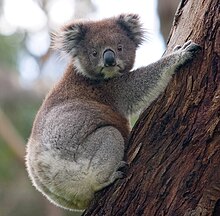
The koala (Phascolarctos cinereus), sometimes inaccurately called the koala bear, is an arboreal herbivorous marsupial native to Australia. It is the only extant representative of the family Phascolarctidae. Its closest living relatives are the wombats. The koala is found in coastal areas of the island's eastern and southern regions, inhabiting Queensland, New South Wales, Victoria, and South Australia. It is easily recognisable by its stout, tailless body and large head with round, fluffy ears and large, dark nose. The koala has a body length of 60–85 cm (24–33 in) and weighs 4–15 kg (8.8–33.1 lb). Its fur colour ranges from silver grey to chocolate brown. Koalas from the northern populations are typically smaller and lighter in colour than their counterparts further south. These populations are possibly separate subspecies, but not all researchers accept this.
Koalas typically inhabit open Eucalyptus woodland, as the leaves of these trees make up most of their diet. This eucalypt diet has low nutritional and caloric content and contains toxic compounds that deter most other mammals from feeding on them. Koalas are largely sedentary and sleep up to twenty hours a day. They are asocial; only mothers bond to dependent offspring. Adult males communicate with bellows that intimidate rivals and attract mates. Males mark their presence with secretions from scent glands located on their chests. Like other marsupials, koalas give birth to young known as joeys at a very early stage of development. They crawl into their mothers' pouches, where they live for their first six to seven months. They are fully weaned around a year old. Koalas have few natural predators and parasites, but are threatened by pathogens such as Chlamydiaceae bacteria and koala retrovirus. (Full article...) -
Image 14St James' Church in about 1890, by Henry King
St James' Church, commonly known as St James', King Street, is an Australian heritage-listed Anglican parish church located at 173 King Street, in the Sydney central business district in New South Wales. Consecrated in February 1824 and named in honour of St James the Great, it became a parish church in 1835. Designed in the style of a Georgian town church by the transported convict architect Francis Greenway during the governorship of Lachlan Macquarie, St James' is part of the historical precinct of Macquarie Street which includes other early colonial era buildings such as the World Heritage listed Hyde Park Barracks.
The church remains historically, socially and architecturally significant. The building is the oldest one extant in Sydney's inner city region. It was added to the New South Wales State Heritage Register on 3 September 2004; and was listed on the (now defunct) Register of the National Estate. (Full article...) -
Image 15
Bronwyn Bancroft AM (born 1958) is an Aboriginal Australian artist, administrator, book illustrator, and among the first three Australian fashion designers to show their work in Paris. She was born in Tenterfield, New South Wales, and trained in Canberra and Sydney.
In 1985, Bancroft established a shop called Designer Aboriginals, selling fabrics made by Aboriginal artists, including herself. She was a founding member of Boomalli Aboriginal Artists Co-operative. Her artwork is held by the National Gallery of Australia, the Art Gallery of New South Wales and the Art Gallery of Western Australia. She illustrated and written 47 ;children's books, including Stradbroke Dreamtime by activist Oodgeroo Noonuccal, and books by artist Sally Morgan. Her design commissions include one for the exterior of a Sydney sports centre. (Full article...)
Selected image

| Credit: Joanjoc |
Luna Park Sydney (originally Luna Park Milsons Point, now formally Sydney's Luna Park) is a historical amusement park, located on the northern shore of Sydney Harbour in Sydney. The heritage-listed park first opened in 1935, and is open for business as of 2013[update], but over its 70-year history, the park has experienced multiple closures, changes of ownership, legal battles, and community action in both support of and opposition to Luna Park's operation.
Related portals
WikiProjects
Selected articles - load new batch
-
Image 1Geologically the Australian state of New South Wales consists of seven main regions: Lachlan Fold Belt, the Hunter–Bowen orogeny or New England Orogen (NEO), the Delamerian Orogeny, the Clarence Moreton Basin, the Great Artesian Basin, the Sydney Basin, and the Murray Basin.
There are a few other sedimentary basins, the Great Artesian Basin can be broken into the Eromanga Basin in the west and the Surat Basin to the east. The Sydney Basin extends north into the Gunnedah Basin, which goes even further north into the Bowen Basin which extends into Queensland, under the Surat Basin. The New England Orogen has a few small Basins included, such as the Lorne Basin, the Myall Syncline, and Gloucester Basin. The Oaklands Basin is in the south of the state under the Murray Basin. The Darling Basin is in the state's west, but mostly covered by the Murray Basin. Gilgandra Sub-Basin and Paka Tank Trough are potential places for coal and gas. (Full article...) -
Image 2
The Hydro Majestic Hotel is located in Medlow Bath, New South Wales, Australia. The hotel is located on a clifftop overlooking the Megalong Valley on the western side of the Great Western Highway.
The hotel is heritage listed and is notable for its unusual mix of architectural styles, including Art Deco and Edwardian. One key feature is the Casino dome (pictured). The dome was bought in Chicago and shipped to Australia, before being shipped to the Blue Mountains by bullock train and reassembled at the site. (Full article...) -
Image 3

University House is a heritage-listed building in Newcastle in New South Wales, Australia. Located on the corner of King Street and Auckland Street, it was designed by architect Emil Sodersten in association with local architectural practice Pitt and Merewether. An example of Art Deco style, the design was inspired by the streamlined functionalism of contemporary architecture in Europe.
The building was constructed between 1937 and 1939 for the Newcastle Electricity Supply Council Administration and was originally known as N.E.S.C.A House. The interior, designed by Guy Allbut, originally comprised a demonstration theatre, showroom, offices and staff accommodation. In 1959, when Shortland County Council became responsible for electricity supply in the Hunter Region, they constructed a three-storey extension at the back of the building. A tower was added in 1967 and remodelling was carried out in 1969 and 1970. After the council vacated the building in 1987, a radio station and an architectural practice moved in. The building only sustained cosmetic damage during the 1989 Newcastle earthquake. In 1995, the University of Newcastle established a library there. It was added to the New South Wales State Heritage Register on 2 April 1999. (Full article...) -
Image 4Sport in New South Wales describes participation in and attendance at organised sports events in the state of New South Wales in Australia. Sport forms an integral part of the culture of the state.
New South Wales has attracted many international multi-sport events including the 2000 Summer Olympics, held in Sydney. There are many professional sporting teams in New South Wales. The biggest sport in the state by a wide margin is rugby league, in which the state has 10 professional clubs in the National Rugby League. Other popular spectator sports include rugby union, cricket, Australian rules football and soccer. In terms of participation, the most popular sports in the state are netball, tennis, soccer, rugby league and touch football. (Full article...) -
Image 5
Sydney is the capital city of the state of New South Wales and the most populous city in Australia. Located on Australia's east coast, the metropolis surrounds Sydney Harbour and extends about 80 km (50 mi) from the Pacific Ocean in the east to the Blue Mountains in the west, and about 80 km (50 mi) from Ku-ring-gai Chase National Park and the Hawkesbury River in the north and north-west, to the Royal National Park and Macarthur in the south and south-west. Greater Sydney consists of 658 suburbs, spread across 33 local government areas. Residents of the city are colloquially known as "Sydneysiders". The estimated population in June 2023 was 5,450,496, which is about 66% of the state's population. The city's nicknames include the Emerald City and the Harbour City.
Aboriginal Australians have inhabited the Greater Sydney region for at least 30,000 years, and their engravings and cultural sites are common. The traditional custodians of the land on which modern Sydney stands are the clans of the Darug, Dharawal and Eora peoples. During his first Pacific voyage in 1770, James Cook charted the eastern coast of Australia, making landfall at Botany Bay. In 1788, the First Fleet of convicts, led by Arthur Phillip, founded Sydney as a British penal colony, the first European settlement in Australia. After World War II, Sydney experienced mass migration and by 2021 over 40 per cent of the population was born overseas. Foreign countries of birth with the greatest representation are mainland China, India, the United Kingdom, Vietnam and the Philippines. (Full article...) -
Image 6
Smoky Cape Lighthouse is a heritage-listed active lighthouse located on Smoky Cape, a headland in Arakoon east of the town of South West Rocks, Kempsey Shire, New South Wales, Australia, and within the Hat Head National Park. It directs boats towards the entrance to the Macleay River, which is located just to the north of the lighthouse.
It is one of the last major lighthouse complexes designed by the New South Wales colonial architect of the time, James Barnet, and was one of Australia's last lighthouses to be designed for architectural excellence.
Standing on a granite headland 111 metres (364 ft) above the sea, its light is the highest in New South Wales. (Full article...) -
Image 7

The Borenore Caves, contained within the Borenore Karst Conservation Reserve, are a series of limestone caves that are located in the Central West region of New South Wales, Australia. The caves are renowned for their karst qualities, namely the numerous fossils from a long-lived reef complex from the Silurian period. Fossils include corals, crinoids, brachiopods, gastropods, pentamerids, colonial tryplasmids and trilobites. Borenore's karst is surrounded by igneous rock that flowed from volcanic eruptions at nearby Mount Canobolas.
The 136-hectare (340-acre) reserve is situated 17 kilometres (11 mi) west of Orange, and is registered as a natural heritage site on the Register of the National Estate for its large diversity of karst morphological and sedimentological features. Camping in the reserve is not permitted. (Full article...) -
Image 8

Football Australia is the governing body of soccer, futsal, and beach soccer within Australia, headquartered in Sydney. Although the first governing body of the sport was founded in 1911, Football Australia in its current form was only established in 1961 as the Australian Soccer Federation. It was later reconstituted in 2003 as the Australian Soccer Association before adopting the name of Football Federation Australia in 2005. In contemporary identification, a corporate decision was undertaken to institute that name to deliver a "more united football" in a deliberation from the current CEO, James Johnson. The name was changed to Football Australia in December 2020.
Football Australia oversees the men's, women's, youth, Paralympic, beach and futsal national teams in Australia, the national coaching programs and the state governing bodies for the sport. It sanctions professional, semi-professional and amateur soccer in Australia. Football Australia made the decision to leave the Oceania Football Confederation (OFC), for which it was a founding member, and become a member of the Asian Football Confederation (AFC) in 2006 and ASEAN Football Federation (AFF) in 2013. (Full article...) -
Image 9Elizabeth Farm, the first item inscribed on the Register
The New South Wales State Heritage Register, also known as NSW State Heritage Register, is a heritage list of places in the state of New South Wales, Australia, that are protected by New South Wales legislation, generally covered by the Heritage Act 1977 and its 2010 amendments. The register is administered by the Heritage Council of NSW via Heritage NSW, a division of the Government of New South Wales Department of Planning and Environment.
The register was created in 1999 and includes items protected by heritage schedules that relate to the State, and to regional and to local environmental plans. As a result, the register contains over 20,000 statutory-listed items in either public or private ownership of historical, cultural, and architectural value. Of those items listed, approximately 1,785 items are listed as significant items for the whole of New South Wales; with the remaining items of local or regional heritage value. The items include buildings, objects, monuments, Aboriginal places, gardens, bridges, landscapes, archaeological sites, shipwrecks, relics, bridges, streets, industrial structures and conservation precincts. (Full article...) -
Image 10
Newcastle, also known as Greater Newcastle, colloquially as Newy and the Steel City, is a large metropolitan area and the second-most-populous city of New South Wales, Australia. It includes the cities of Newcastle and Lake Macquarie and it is the hub of the Lower Hunter region, which includes most parts of the cities of Newcastle, Lake Macquarie, Maitland, Cessnock, and Port Stephens Council.
Located at the mouth of the Hunter River, it is the predominant city within the Hunter Region. Famous for its coal, the Port of Newcastle is the largest coal exporting harbour in the world, exporting 143 million tonnes of coal in 2022.
Newcastle has traditionally been an industrial hub with working class roots. Although industry is still part of the fabric of Newcastle, "Newy" also boasts some of Australia's most picturesque beaches, a world-class University, large hospitals, a strong local music scene (producing such acts as Silverchair), a robust regional economy, an emerging renewable energy hub, and sporting teams which compete in national leagues (Newcastle Knights, Newcastle Jets). "Newy" is known for its unique cultural identity as a city and is often referred to as "God's country" by locals and those who visit. Novocastrians (citizens of Newcastle) are known to be extremely proud to call Newcastle home. (Full article...) -
Image 11
Tamworth is a city and administrative centre of the north-eastern region of New South Wales, Australia. Situated on the Peel River within the local government area of the Tamworth Regional Council, it is the largest and most populated city in the region, with a population of 43,874 in 2021, making it the third largest inland city in New South Wales (after Wagga Wagga and Albury). Tamworth is 318 km (198 mi) from the Queensland border and is located almost midway between Brisbane and Sydney.
The city is known as the "First Town of Lights", being the first place in Australia to use electric street lights in 1888. Tamworth is also famous as the "Country Music Capital of Australia" and "Australia's answer to Nashville", annually hosting the Tamworth Country Music Festival in late January; the second-biggest country music festival in the world after Nashville. The city is recognised as the National Equine Capital of Australia because of the high number of equine events held in the city and the construction of the world-class Australian Equine and Livestock Events Centre, the biggest of its kind in the Southern Hemisphere. (Full article...) -
Image 12An outbreak of equine influenza (EI) in Australia was confirmed by the Department of Primary Industries (New South Wales) on 24 August 2007 in Sydney. Also known as "horse flu" and "A1 influenza", the rapid outbreak was of the Influenza A virus strain of subtype H3N8. While the virus is highly contagious, it rarely kills adult horses but the performance of thoroughbred racing horses can be affected for several weeks. It can be fatal to young foals and debilitated horses.
Because of strict quarantine procedures to reduce the risk of exotic pests and diseases entering Australia, this was the first outbreak of equine influenza in Australia. Horses in Australia had not been exposed to the virus and, not being vaccinated, were fully susceptible. (Full article...) -
Image 13

Children outside some of the 27 houses at Boggabilla Station, November 1952.
Aboriginal reserves in New South Wales, together with Stations, and Aboriginal Missions in New South Wales were areas of land where many Aboriginal people were forced to live in accordance with laws and policies. The British government, which controlled the Australian colonies, and later the state governments had various policies of segregation and assimilation. The Aboriginal reserves were established by government authorities as portions of land set aside for the sole use of Aboriginal people, a practice that continued after Federation in 1901. Of the 85 Aboriginal reserves created from 1885 to 1895, 47 were initiated by Aboriginal families. The Register of Aboriginal Reserves 1875-1904 held by NSW State Archives includes a map of the locality and a description of the area and whether it is good for hunting and fishing.
The reserves were operated under the direction of various government authorities including the Aborigines Protection Board (1883–1940), the Aborigines Welfare Board (1940–1969) and the Aborigines Welfare Directorate (1969–1975). (Full article...) -
Image 14The COVID-19 pandemic in New South Wales, Australia was part of the worldwide pandemic of the coronavirus disease 2019 (COVID-19) caused by severe acute respiratory syndrome coronavirus 2 (SARS-CoV-2). The first confirmed case in New South Wales was identified on 19 January 2020 in Sydney where three travellers returning from Wuhan, Hubei, China, tested positive for the virus.
As of 1 April 2022[update], there had been over 1,863,186 confirmed cases in NSW: 1,149,142 confirmed cases from PCR testing, and nearly 714,044 positive rapid antigen tests (RAT) since mid-January 2022. 17,509,209 vaccines have been administered. (Full article...) -
Image 15Bird's-eye view of the Parramatta River as it heads to Port Jackson, looking east towards Sydney CBD from Gladesville Bridge
The Parramatta River is an intermediate tide-dominated, drowned valley estuary located in Sydney, New South Wales, Australia. With an average depth of 5.1 metres (17 ft), the Parramatta River is the main tributary of Sydney Harbour, a branch of Port Jackson. Secondary tributaries include the smaller Lane Cove and Duck rivers.
Formed by the confluence of Toongabbie Creek and Darling Mills Creek at North Parramatta, the river flows in an easterly direction to a line between Yurulbin in Birchgrove and Manns Point in Greenwich. Here, it flows into Port Jackson, about 21 kilometres (13 mi) from the Tasman Sea. The total catchment area of the river is approximately 252.4 square kilometres (97.5 sq mi) and is tidal to Charles Street Weir in Parramatta, approximately 30 kilometres (19 mi) from the Sydney Heads. (Full article...)
Did you know (auto-generated)

- ... that in its two years of existence, the Hunter River Railway Company initiated construction on what would eventually become the Great Northern Railway connecting Sydney to Queensland?
- ... that many an Xplorer has traversed the rails in Canberra?
- ... that the rural village of Neath, New South Wales, had a population of three Tok Pisin speakers in 2021?
- ... that Turkish international soccer player Rojin Polat was named member of the "2021 All Schools Merit Girls Team" in New South Wales, Australia?
General images - load new batch
-
Image 1Dry paddocks in the Riverina region during the 2007 drought (from History of New South Wales)
-
Image 2Tumut 3 Power Station was constructed as part of the vast Snowy Mountains Scheme in New South Wales (1949–1974). Construction necessitated the expansion of Australia's immigration program. (from History of New South Wales)
-
Image 4Japanese POW camp at Cowra, shortly before the Cowra breakout (from History of New South Wales)
-
Image 5World leaders with Prime Minister John Howard in Sydney for the 2007 APEC conference (from History of New South Wales)
-
Image 7Humanitarian Caroline Chisholm provided support to poverty-stricken women migrants (from History of New South Wales)
-
Image 8A bulk carrier entering the Port of Newcastle, New South Wales, 2009 (from Economy of New South Wales)
-
Image 9Mr E.H. Hargraves, The Gold Discoverer of Australia, returning the salute of the gold miners - Thomas Tyrwhitt Balcombe, 1851 (from History of New South Wales)
-
Image 10Ribbon ceremony to open the Sydney Harbour Bridge on 20 March 1932. Breaking protocol, the soon to be dismissed Premier Jack Lang cuts the ribbon while Governor Philip Game looks on. (from History of New South Wales)
-
Image 12The 5th Governor of New South Wales, Lachlan Macquarie, was influential in establishing civil society in Australia (from History of New South Wales)
-
Image 14Olympic colours on the Sydney Harbour Bridge in the year 2000 (from History of New South Wales)
-
Image 15The New South Wales Parliament is Australia's oldest parliament. (from History of New South Wales)
-
Image 16Landing of Lieutenant James Cook at Botany Bay, 29 April 1770, by E. Phillips Fox (from History of New South Wales)
-
Image 18A chart of part of the interior of New South Wales by John Oxley, Surveyor General, 1822 (from History of New South Wales)
-
Image 19A General Chart of New Holland including New South Wales & Botany Bay with The Adjacent Countries and New Discovered Lands, published in An Historical Narrative of the Discovery of New Holland and New South Wales, London, Fielding and Stockdale, November 1786 (from History of New South Wales)
-
Image 21Federation Pavilion, Centennial Park, Sydney, 1 January 1901. (from History of New South Wales)
-
Image 22William Wentworth was key in the establishment of self-governance in New South Wales (from History of New South Wales)
-
Image 24Hyde Park, Sydney with the Australian Museum under construction in the distance, 1842 (from History of New South Wales)
-
Image 26Founding of the settlement of Port Jackson at Botany Bay in New South Wales in 1788, by Thomas Gosse (from History of New South Wales)
Topics
Categories
More portals
In the news
- 5 January 2025 – 2025 United Cup
- In tennis, the United States wins its second United Cup title after defeating Poland 2–0 in the final at the Ken Rosewall Arena in Sydney, Australia. (Reuters)
Associated Wikimedia
The following Wikimedia Foundation sister projects provide more on this subject:
-
Commons
Free media repository -
Wikibooks
Free textbooks and manuals -
Wikidata
Free knowledge base -
Wikinews
Free-content news -
Wikiquote
Collection of quotations -
Wikisource
Free-content library -
Wikiversity
Free learning tools -
Wikivoyage
Free travel guide -
Wiktionary
Dictionary and thesaurus

